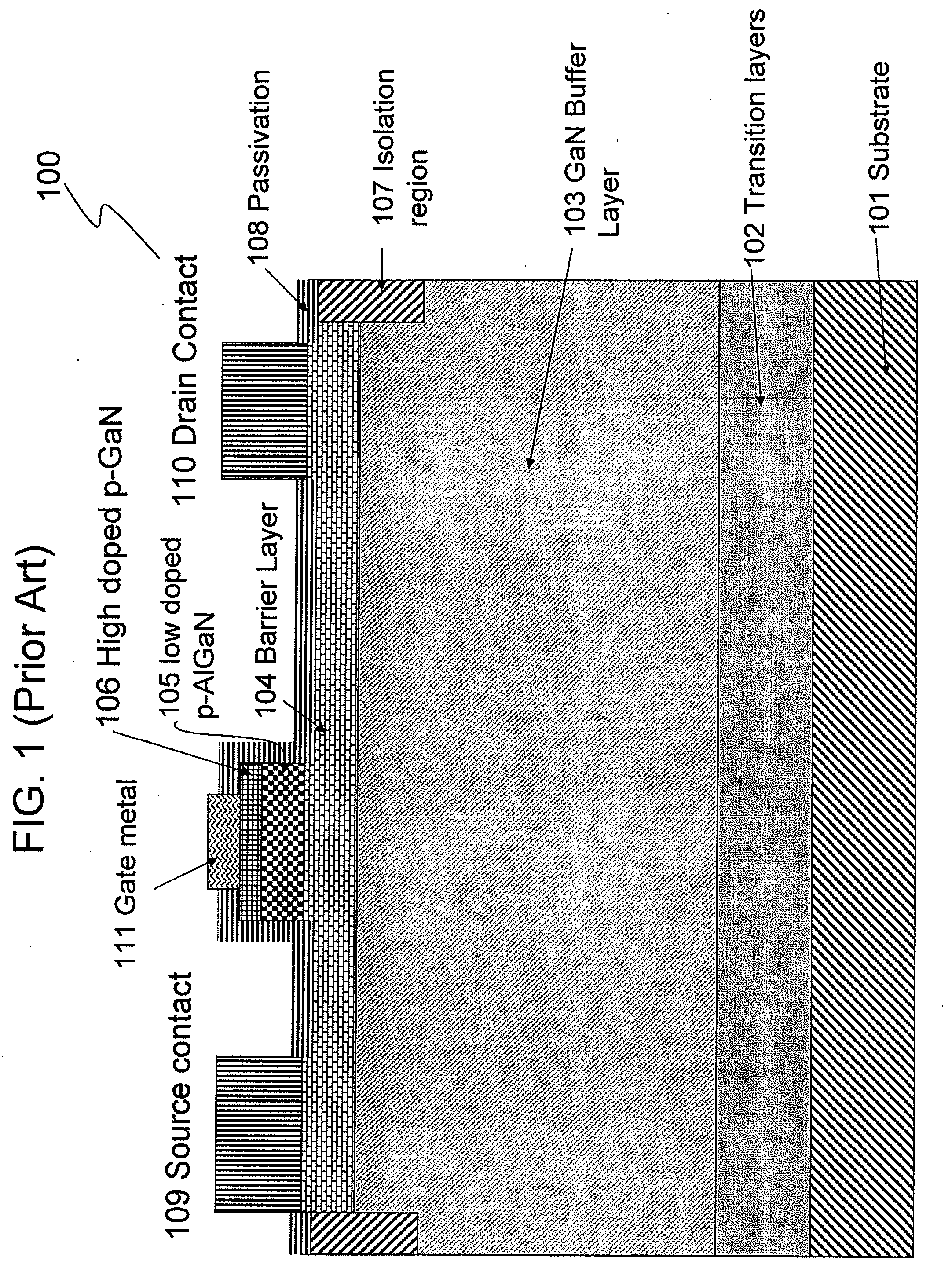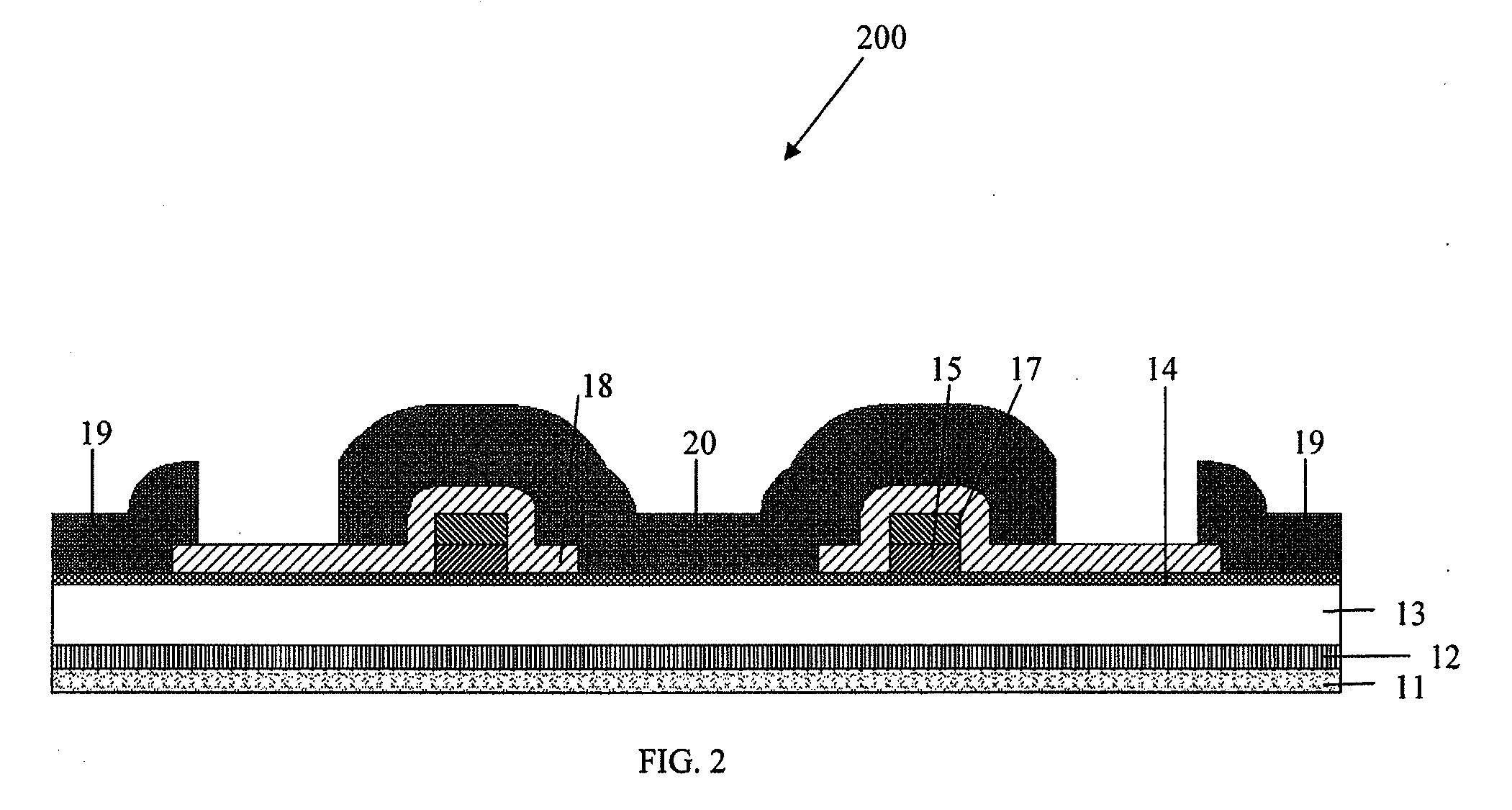ENHANCEMENT MODE GaN HEMT DEVICE AND METHOD FOR FABRICATING THE SAME
a technology of enhanced mode and hemt, which is applied in the direction of semiconductor devices, basic electric elements, electrical equipment, etc., can solve the problems of high gate leakage current, gate reliability risk, and increased manufacturing cost of fabrication
- Summary
- Abstract
- Description
- Claims
- Application Information
AI Technical Summary
Benefits of technology
Problems solved by technology
Method used
Image
Examples
first embodiment
[0023]Referring to FIGS. 2 and 3A-3E, a first embodiment is now described for forming an enhancement mode GaN HEMT device with a self-aligned gate, wherein like reference numbers are used consistently for like features throughout the drawings. FIG. 2 illustrates an enhancement mode GaN HEMT device 200 formed by the method described below with respect to FIGS. 3A-3E, which has a gate metal 17 and a p-type GaN material 15 that are self-aligned. Device 200 includes a silicon substrate 11, transition layers 12, un-doped GaN buffer material 13, un-doped AlGaN barrier material 14, p-type GaN gate layer 15, gate metal 17, dielectric material 18, drain ohmic contact 19, and source ohmic contact 20. The source metal 20 also serves as a field plate that extends over the gate and toward the drain contact. Layers 13, 14, and 15 are made of a III Nitride material. A III Nitride material can be composed of InxAlyGa1−x−yN, where x+y≦1.
[0024]FIG. 3A illustrates the EPI structure of GaN HEMT device ...
second embodiment
[0030]Referring to FIGS. 4 and 5A-5E, the invention is now described. FIG. 4 illustrates an enhancement mode GaN HEMT device 200 formed by the method shown in FIGS. 5A-5E, which results in a gate metal 17, a p-type GaN gate layer 15, and a p-type AlGaN material 21 that are self-aligned. Device 200 in FIG. 4 differs from device 200 of FIGS. 2 and 3A-3E in that it includes an additional layer, namely the layer formed of p-type AlGaN material 21.
[0031]FIG. 5A illustrates the EPI structure, including, from bottom to top, silicon substrate 11, transition layers 12, un-doped GaN buffer material 13, un-doped AlGaN barrier material 14, p-type AlGaN material 21, and p-type GaN material 15. The dimensions and compositions of the various layers are similar to that of the first embodiment. The additional layer of p-type AlGaN material 21 preferably has a thickness of about 20 Å to about 300 Å, and includes Al from about 12 to about 100 percent of the AlGaN material.
[0032]As shown in FIG. 5B, as...
ninth embodiment
[0048]In a ninth embodiment, the p-GaN material 15 is formed by introducing magnesium (Mg) impurities during the growth of the top EPI layer, for example, in FIG. 3A. Magnesium is the most common impurity atom used to create acceptor-rich (p-type) GaN.
PUM
| Property | Measurement | Unit |
|---|---|---|
| angle | aaaaa | aaaaa |
| angle | aaaaa | aaaaa |
| angle | aaaaa | aaaaa |
Abstract
Description
Claims
Application Information
 Login to View More
Login to View More - R&D
- Intellectual Property
- Life Sciences
- Materials
- Tech Scout
- Unparalleled Data Quality
- Higher Quality Content
- 60% Fewer Hallucinations
Browse by: Latest US Patents, China's latest patents, Technical Efficacy Thesaurus, Application Domain, Technology Topic, Popular Technical Reports.
© 2025 PatSnap. All rights reserved.Legal|Privacy policy|Modern Slavery Act Transparency Statement|Sitemap|About US| Contact US: help@patsnap.com



